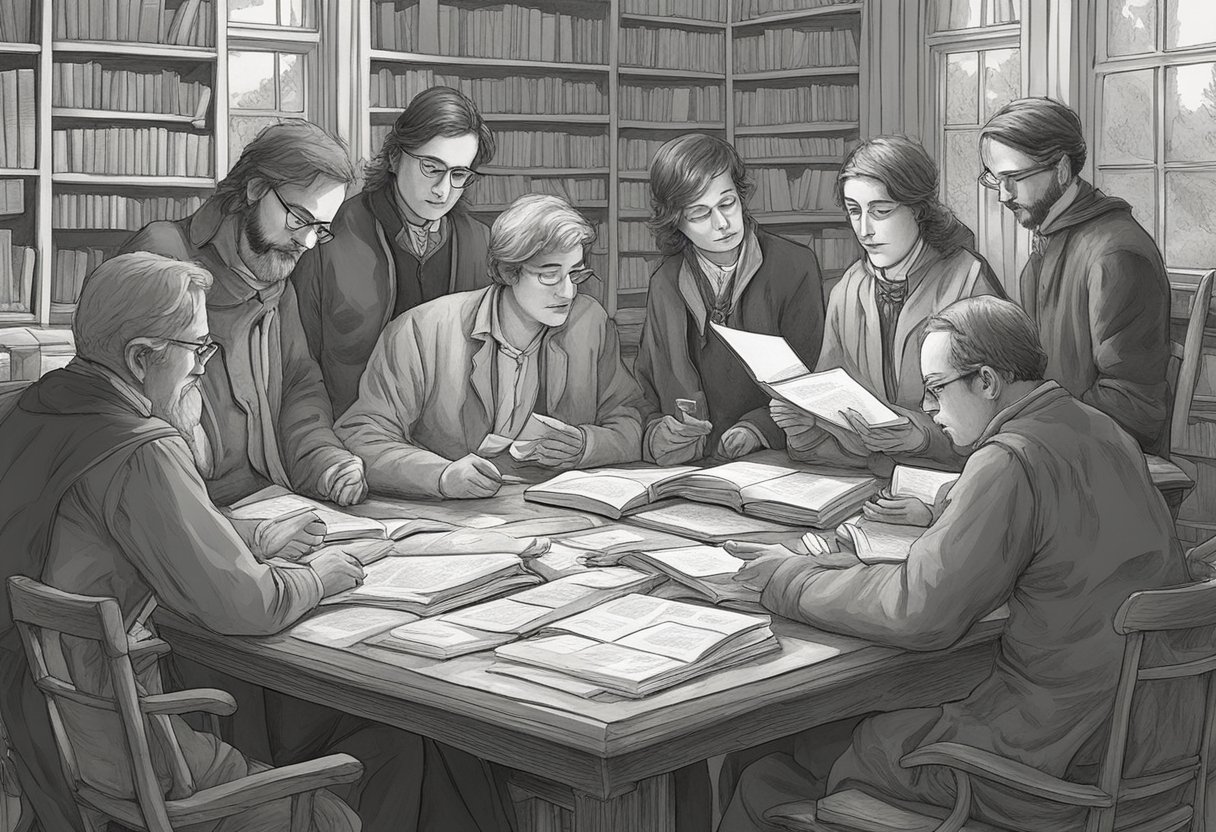Epitaph poetry is a unique form of poetry that captures the essence of a person’s life in a few words. It is a powerful way to remember someone who has passed away and to honour their memory.
Teaching epitaph poetry can be a challenging task, but it can also be a rewarding experience for both teachers and students.
Related: For more, check out our article on How To Teach Couplet Poetry here.

To teach epitaph poetry effectively, it is crucial to have a good understanding of what epitaphs are and the elements that make up an epitaph poem. This includes understanding the purpose of an epitaph, the different types of epitaphs, and the key elements that make up an epitaph poem.
Once teachers have a solid understanding of these concepts, they can begin to teach their students how to write their own epitaph poems.
Teaching epitaph poetry can be a creative and engaging way to help students explore the themes of life and death. It can also be an excellent opportunity for students to develop their writing skills and express themselves in a unique and meaningful way.
With the right teaching strategies and resources, teachers can help their students to write powerful and memorable epitaph poems that honour the memory of those who have passed away.
Key Takeaways
- Understanding the purpose and elements of epitaph poetry is crucial for teaching it effectively.
- Teaching epitaph poetry can be a creative and engaging way to explore the themes of life and death.
- With the right teaching strategies and resources, students can write powerful and memorable epitaph poems that honour the memory of those who have passed away.
Related: For more, check out our article on How To Teach Pantoum Poetry here.
Understanding Epitaphs

Epitaphs are short poems or phrases that are written to commemorate the life of someone who has passed away. They are often inscribed on gravestones or memorials and serve as a way to honour the deceased.
Historical Context
Epitaphs have a long history that dates back to ancient Greece and Rome. In ancient Greece, epitaphs were often written in verse and inscribed on tombstones to honour the dead.
These epitaphs usually included the name of the deceased, their accomplishments, and a message of farewell.
Similarly, in ancient Rome, epitaphs were inscribed on tombstones and often included the name of the deceased, their age, and a message of farewell. These epitaphs were often written in Latin and were intended to be read by future generations.
Cultural Significance
Epitaphs hold cultural significance as they provide a window into the beliefs and values of a particular culture or society. For example, in ancient Egypt, epitaphs were often inscribed on tombs and were believed to provide protection for the deceased in the afterlife.
These epitaphs were often accompanied by images and symbols that were believed to have magical powers.
In modern times, epitaphs continue to hold cultural significance and are often used as a way to express grief and honour the deceased. They can be written in a variety of styles, from serious and sombre to humorous and lighthearted.
Overall, understanding the historical context and cultural significance of epitaphs can help one appreciate the importance of these short poems and phrases in commemorating the lives of those who have passed away.
Related: For more, check out our article on How To Teach Ekphrastic Poetry here.
Elements of Epitaph Poetry
Epitaph poetry is a form of commemorative poetry that is used to remember the life of someone who has passed away. The poetry is usually short, and it is written to be inscribed on a tombstone or memorial.
There are three key elements to epitaph poetry: structure and form, language and imagery, and tone and mood.
Structure and Form
Epitaphs are usually written concisely and straightforwardly. They are often written in a traditional form, such as a couplet or quatrain.
The structure of an epitaph is often dictated by the length of the inscription. For example, a longer epitaph may be written in a more complex form, such as a sonnet or an ode.
Language and Imagery
The language used in an epitaph is often simple and direct. The poet may use metaphor or simile to create an image that captures the essence of the person being remembered.
The imagery used in an epitaph is often related to the person’s life or character. For example, if the person being remembered was a gardener, the epitaph may include imagery related to nature or growth.
Tone and Mood
The tone and mood of an epitaph can vary depending on the person being remembered and the circumstances of their death. Some epitaphs are sombre and reflective, while others are more lighthearted and celebratory.
The tone and mood of an epitaph can be conveyed through the language used, the imagery employed, and the structure of the poem.
Epitaph poetry shares some similarities with other forms of poetry, such as elegies. However, the main difference between an epitaph and an elegy is that an epitaph is intended to be inscribed on a tombstone or memorial, while an elegy is a poem that mourns the loss of someone who has passed away.
Other forms of poetry, such as sonnets, limericks, and acrostics, can also be used to write epitaphs, depending on the length and style of the inscription required.
Related: For more, check out our article on How To Teach Sestina Poetry here.
Writing Epitaph Poems
Writing an epitaph poem can be a creative and meaningful way to honour the memory of someone who has passed away. Whether it’s serious or humorous, an epitaph poem can capture the essence of a person’s life in a few short lines.
Themes and Topics
When deciding on a theme or topic for an epitaph poem, it’s important to consider the personality and interests of the deceased. Some common themes include love, family, nature, and spirituality.
However, the possibilities are endless, and writers should feel free to explore any topic that resonates with them.
Crafting the Inscription
Crafting the inscription for an epitaph poem can be a challenging task, but the following tips can help:
- Keep it short and sweet: An epitaph poem is typically only a few lines long, so every word counts. Choose phrases that are concise and impactful.
- Use vivid imagery: Paint a picture with words by using descriptive language that creates a mental image.
- Be creative: Don’t be afraid to think outside the box and come up with a unique inscription that captures the essence of the person being honoured.
Incorporating Humor and Seriousness
An epitaph poem can be serious, humorous, or a combination of both. It’s up to the writer to decide what tone is appropriate for the situation. If the deceased had a good sense of humour, a funny epitaph poem might be a fitting tribute.
On the other hand, if the person was known for their seriousness, a more sombre inscription might be more appropriate.
When incorporating humour, it’s important to be respectful and avoid anything that could be seen as offensive. Using puns, wordplay, or clever phrasing can be a great way to inject some levity into an otherwise serious situation.
Overall, writing an epitaph poem can be a cathartic and meaningful experience for both the writer and those who will read it. By following these tips and using creativity and sensitivity, writers can craft an inscription that honours the memory of their loved one in a beautiful and lasting way.
Related: For more, check out our article on How To Teach Cinquain Poetry here.
Teaching Strategies for Epitaph Poetry
Lesson Planning
When planning a lesson on epitaph poetry, teachers should begin by introducing the concept of an epitaph and its purpose.
They should explain that an epitaph is a short poem that commemorates the life of someone who has passed away. Teachers should also provide examples of epitaphs to help students understand the structure and content of these poems.
To ensure that students have a clear understanding of the different elements of an epitaph, teachers can create a graphic organizer or a table that outlines the key components of an epitaph.
This can include information such as the name of the deceased, their date of birth and death, and a brief description of their life or accomplishments.
Classroom Activities
To help students develop their skills in writing epitaphs, teachers can engage them in a range of activities. One effective strategy is to provide students with a range of prompts or scenarios that they can use to create their own epitaphs.
For example, teachers can ask students to imagine that they are writing an epitaph for a historical figure or a fictional character.
Another approach is to encourage students to work collaboratively in small groups to create their own epitaphs. This can help to foster a sense of community and encourage students to share their ideas and perspectives with one another.
Assessment Methods
When assessing students’ work in epitaph poetry, teachers should focus on a range of criteria, including the structure and content of the poem, as well as the use of literary devices such as metaphor, imagery, and symbolism.
Teachers can also assess students’ ability to revise and edit their work to ensure that it is clear, concise, and effective.
To provide students with feedback on their work, teachers can use a range of assessment methods, such as rubrics or checklists.
These tools can help to ensure that students understand the expectations for their work and can help to guide them in the revision and editing process.
In summary, teaching epitaph poetry can be an effective way to help students develop their skills in writing and literary analysis.
By providing students with a range of prompts and activities, as well as clear assessment criteria, teachers can help to ensure that students are engaged and motivated in their learning.
Related: For more, check out our article on How To Teach Elegy Poetry here.
Exploring Notable Epitaph Poets

Epitaphs are short poems that are often inscribed on tombstones and serve as a brief elegy for the deceased. Many notable poets have written epitaphs, including William Shakespeare, Robert Louis Stevenson, and John Donne.
William Shakespeare
William Shakespeare is one of the most famous poets and playwrights in English literature. He wrote many epitaphs, including one for his own tombstone, which reads:
Good friend, for Jesus’ sake forbear,
To dig the dust enclosed here.
Blessed be the man that spares these stones,
And cursed be he that moves my bones.
This epitaph is a warning to anyone who might disturb Shakespeare’s remains.
Robert Louis Stevenson
Robert Louis Stevenson was a Scottish novelist, poet, and travel writer. He wrote an epitaph for himself that reads:
Under the wide and starry sky,
Dig the grave and let me lie.
Glad did I live and gladly die,
And I laid me down with a will.
Stevenson’s epitaph expresses his love of life and his acceptance of death.
John Donne
John Donne was an English poet and cleric in the Church of England. He wrote many famous poems, including several epitaphs. One of his most famous epitaphs is for his wife, Anne Donne, who died in 1617. The epitaph reads:
Here lies a she sun and a he moon there,
She gives the best light to his sphere,
Or each is both, and all, and so
They unto one another nothing owe.
This epitaph is a tribute to Donne’s wife and their love for each other.
Overall, these poets and their epitaphs show the power of poetry to express deep emotions and commemorate the lives of those who have passed away.

